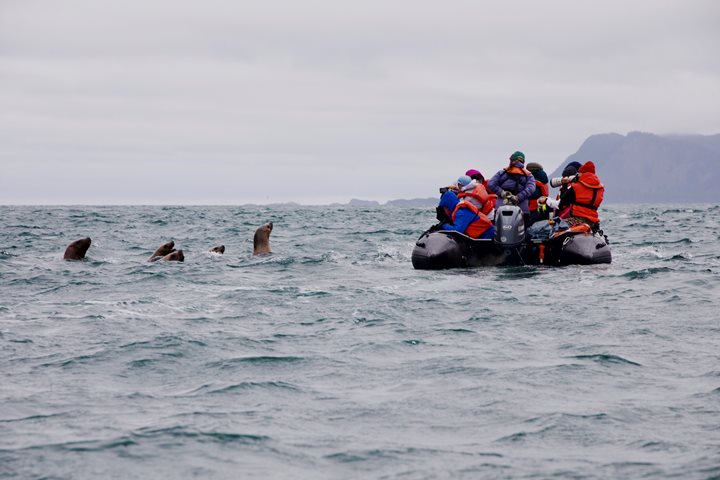Just before the light of day, National Geographic Sea Bird made her way towards Government Dock in Alert Bay on Cormorant Island in British Columbia. Our floating home cruised all night, making her way across Queen Charlotte Sound before finally entering Johnstone Strait at its northernmost end. Cormorant Island is located just south of this location and was our destination. Alert Bay is home to the Namgis band of the Kwakwaka’wakw Nation.
After docking, we made our way to the U’mista Cultural Center to get acquainted with another of the many Indigenous Nations that make up the northwest coast of North America. We were greeted by several of the people who manage the Cultural Center, and we eventually divided into two groups. One group made its way to the Potlatch Collection, while the other half enjoyed a film from Namgis filmmaker Barbara Cranmer in the upper half of the cultural center.
The center was established in 1980 and houses a very important collection of potlatch regalia that was stolen from the Kwakwaka’wakw Nation in 1921 by the Canadian government, which had outlawed potlatches. The potlatch was held on Village Island. The people of Alert Bay petitioned the Canadian government for the return of their stolen regalia and were told, “If you build a museum, we will return your regalia.” The museum was built, and repatriation began. The Namgis people of Alert Bay were among the first to create an interpretive center/museum to tell the story of their treasures from their point of view! Alert Bay became a vocal community from that time forward. Many other Indigenous nations along the northwest coast followed suit by creating interpretive centers to house their own treasures and preserve the Living Cultures of the Northwest Coast peoples for future generations.
We arrived in Alert Bay on an unusual day, as there was a community wide power outage from 10 am to 4 pm. This required the U’mista Cultural Center and our natural history staff to design a day of operations without power. At 10 am sharp, the electricity in Alert Bay shut down. Just before then, Bruce Alfred arrived on site and conducted a tour through the Potlatch Collection in the lower end of the Cultural Center. The lights went out, and Bruce kept talking! The staff came down to the collection area and let us know that it was time to exit the Cultural Center.
Outside, Bruce gathered us all for an in-depth discussion on carving and the creation of bentwood boxes. He is considered a world expert in this fine art form. With a wicked sense of humor and through a very detailed discussion, Bruce explained the complexity of constructing bentwood construction. A very intricate form of box construction that is more than 5,000 years in age, this style of box continues today with “new” tools introduced by non-natives.
As we listened from under the protection of a tent, we watched the fall weather slowly making its way down channel, headed for Alert Bay. Our group made its way back to the ship for lunch. We made a brief stop at the ancestral burial grounds of the Namgis people. We were met by another community member, Brendon, who walked us through the many totem poles and detailed their history and importance.
After lunch and hosting several community members on board National Geographic Sea Bird, we gathered once again for a short journey to “Gator Gardens.” This marshy area was renamed Alert Bay’s Ecological Park in 1998. The water is part of a backed up, swampy area that is made by a dam created in 1870 to bring fresh water to several canneries along the waterfront of Alert Bay. Those canneries operated until 1941. It took five years for the top of the hill to flood, eventually killing the trees and creating a bog-like environment that exists to this day with old growth western red cedar trees standing like giant sculptures.
The weather finally hit Alert Bay, and rain came down in torrents as we made our way through the forest. We were sheltered from much of the rain under western hemlocks, some of which were old growth trees and mammoth in size!
Eventually, we made our way back downhill to the ship. Once everyone was on board, National Geographic Sea Bird made her way south to Blackfish Sound. This area of moving sea currents is home to many marine mammals and seabirds. We made our way through a grey and rainy day with shades of dark green as we watched humpback whales. Seabirds made their living on the rich resources of the ocean water that make up Blackfish Sound and Johnstone Strait. Today was another amazing day exploring the many regions that make up the Inside Passage and the waters inhabited by Indigenous peoples for many thousands of years.







